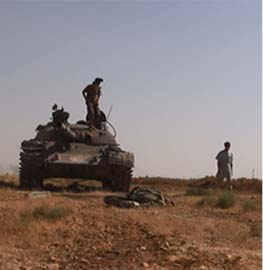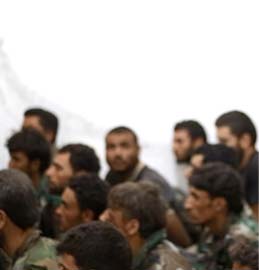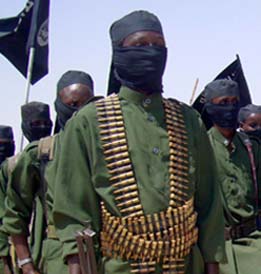
An anonymous Iranian official told Reuters on April 6 that Islamic Republic Supreme Leader Ali Khamenei has instructed Iranian armed forces to be on high alert. The source also said Tehran has threatened neighboring states with “severe consequences” if they allow the US to use their airspace to strike targets within Iranian territory.
In line with these threats, Iran’s state-controlled media has escalated its rhetoric by vowing to assassinate US President Donald Trump and disseminating propaganda videos. Iran’s Kayhan newspaper, closely affiliated with the supreme leader, called for the assassination of Trump for his role in eliminating former Islamic Revolutionary Guard Corps-Quds Force (IRGC-QF) General Qassem Soleimani in 2020. Iranian outlets also circulated an AI-generated video depicting an IRGC-led nuclear attack against the US base on the island of Diego Garcia in the Indian Ocean.
Tehran’s latest hostile messaging came shortly after news of a further American military buildup across the Middle East. In March, some 140 heavy transport aircraft delivered military assets to US bases in Qatar, Bahrain, the UAE, Saudi Arabia, Kuwait, and Jordan. The deployments included A-10 ground-attack aircraft to Jordan, F-35 multirole fighters to Saudi Arabia, and nearly one-third of the US’s B-2 stealth bomber fleet to Diego Garcia. Additionally, the US sent cargo planes transporting Patriot and THAAD (Terminal High Altitude Area Defense) batteries for air defense purposes in the Persian Gulf, while additional deployments supported the USS Truman carrier strike group in the Red Sea.
Amid growing fears of a potential US or Israeli strike, Iran has sharply intensified its military posture across land, sea, and air. The IRGC has fortified islands in the Persian Gulf with fast-attack vessels equipped with new cruise missiles. These moves are part of a broader military buildup, including joint drills with Russia and China in the Gulf of Oman and large-scale exercises simulating strikes on nuclear infrastructure. Iran has also showcased drones with extended range and stealth capabilities while reinforcing defenses near key nuclear sites.
Israel prefers the “Libyan model” but signals a diplomatic solution is unlikely
During an April 7 meeting with Trump, Israeli Prime Minister Benjamin Netanyahu reportedly advocated for the 2003 “Libyan model” toward Iran, a template of exchanging economic benefits and sanctions relief for voluntary, complete dismantlement of Tehran’s nuclear program. Axios also reported that Jerusalem seeks to reach an understanding with Washington over targeting Iran’s nuclear infrastructure should negotiations fail, adding that Israel doesn’t view a renewed nuclear deal as likely.
Israel’s rhetoric, including consistent messaging against the Islamic Republic since the October 2023 Hamas terrorist attack, suggests that Jerusalem’s military establishment may see a war with Iran as inevitable.
Netanyahu described the November 2024 ceasefire with Lebanon and, by extension, Hezbollah, as an opportunity to “focus on Iran.” Similarly, on March 5, Israel Defense Forces Chief of Staff Eyal Zamir declared 2025 the year devoted to prioritizing a military confrontation with Tehran. The next day, the Israeli and US Air Forces conducted a joint exercise featuring F-15I and F-35I fighter jets alongside a B-52 bomber—assets Israel may rely on for a strike against Iran’s underground nuclear facilities. Israel’s airstrikes in October 2024 that targeted Iranian air defense systems paved the way for such an operation, also signaling its potential.
Iraqi militias reportedly prepare for disarmament
Major Iran-backed Iraqi militias have expressed a willingness to disarm amid escalating tensions between Tehran and Washington. The Kataib Hezbollah, Al Nujaba, Kataib Sayyid Al Shuhada, and Ansar Allah al Awfiyaa militias, all of which have leaders or are entities designated by the US as Specially Designated Global Terrorists or Foreign Terrorist Organizations, comprise the core of Tehran’s Iraqi proxies. This move comes after a series of meetings between IRGC-QF Commander Esmail Ghaani and Iraqi militia leaders in which Tehran has urged the network to avoid provoking Israel and the United States.
IRGC suffers losses in Yemen
A US airstrike on Tuesday that struck a Houthi gathering in Al Fazah, a coastal district of Hodeidah along the Red Sea, killed 70 individuals, including senior field commanders and Iranian IRGC experts, Yemen’s internationally recognized government announced on April 4. Yemeni Minister of Information Moammar al Eryani confirmed the strike, emphasizing its impact on both the Houthis’ leadership structure and their external military support network.
Amid a sustained US bombing campaign against the Houthis, Iran reportedly instructed its military personnel to withdraw from Yemen, signaling a recalibration of its regional strategy under mounting pressure from the Trump administration. Tehran had already urged the Houthis to de-escalate in the Red Sea as early as March 18, relaying this message through both its envoy and Oman.







